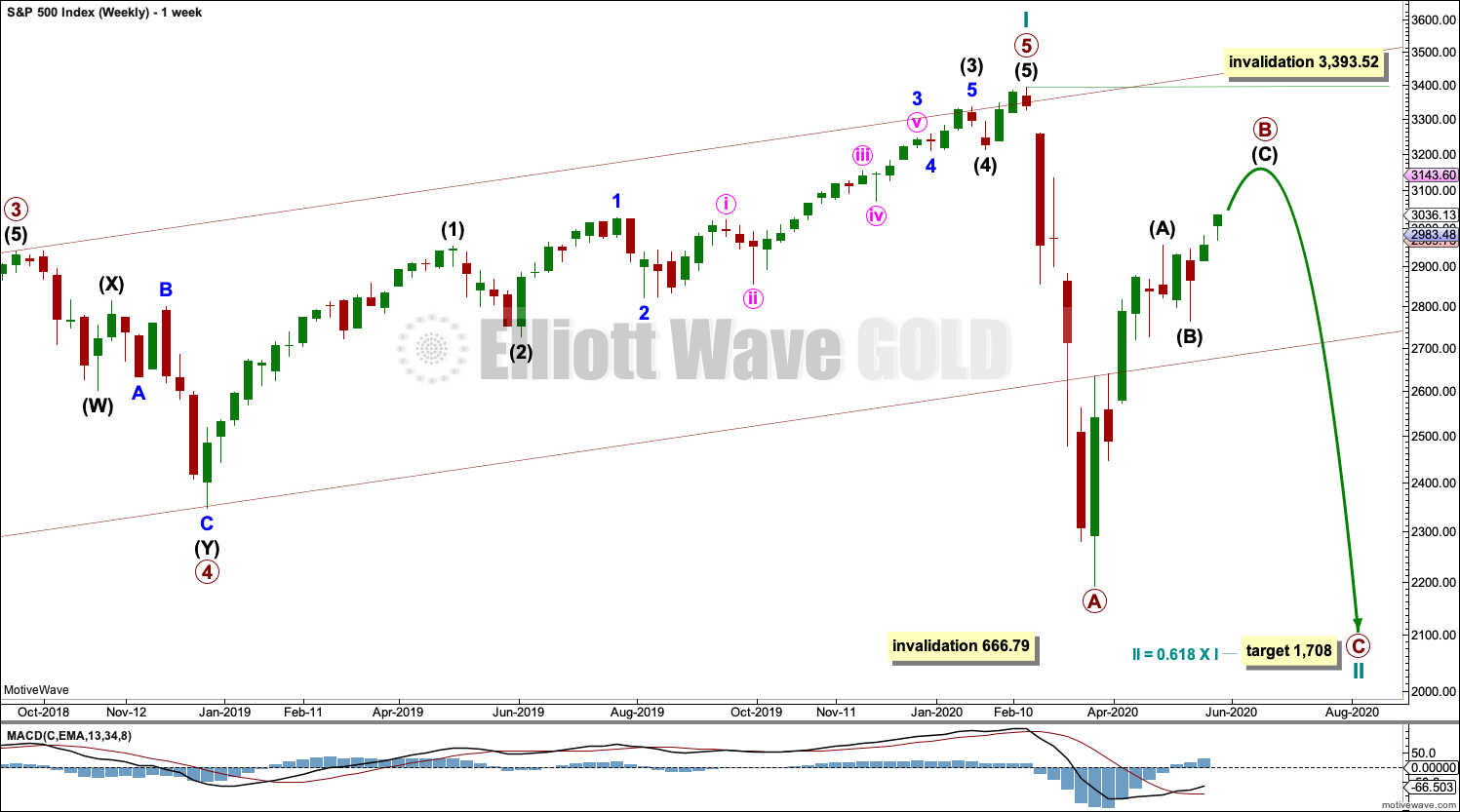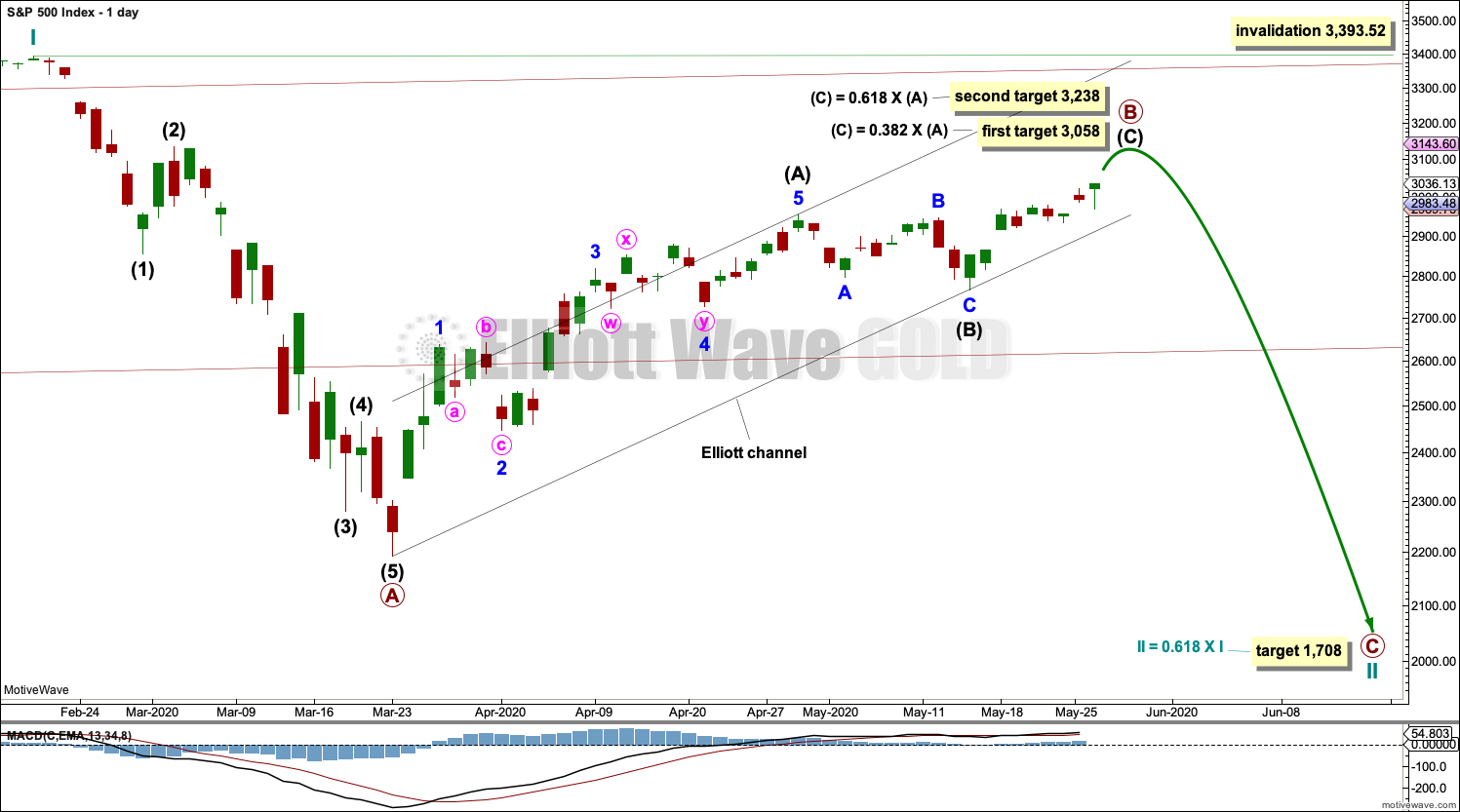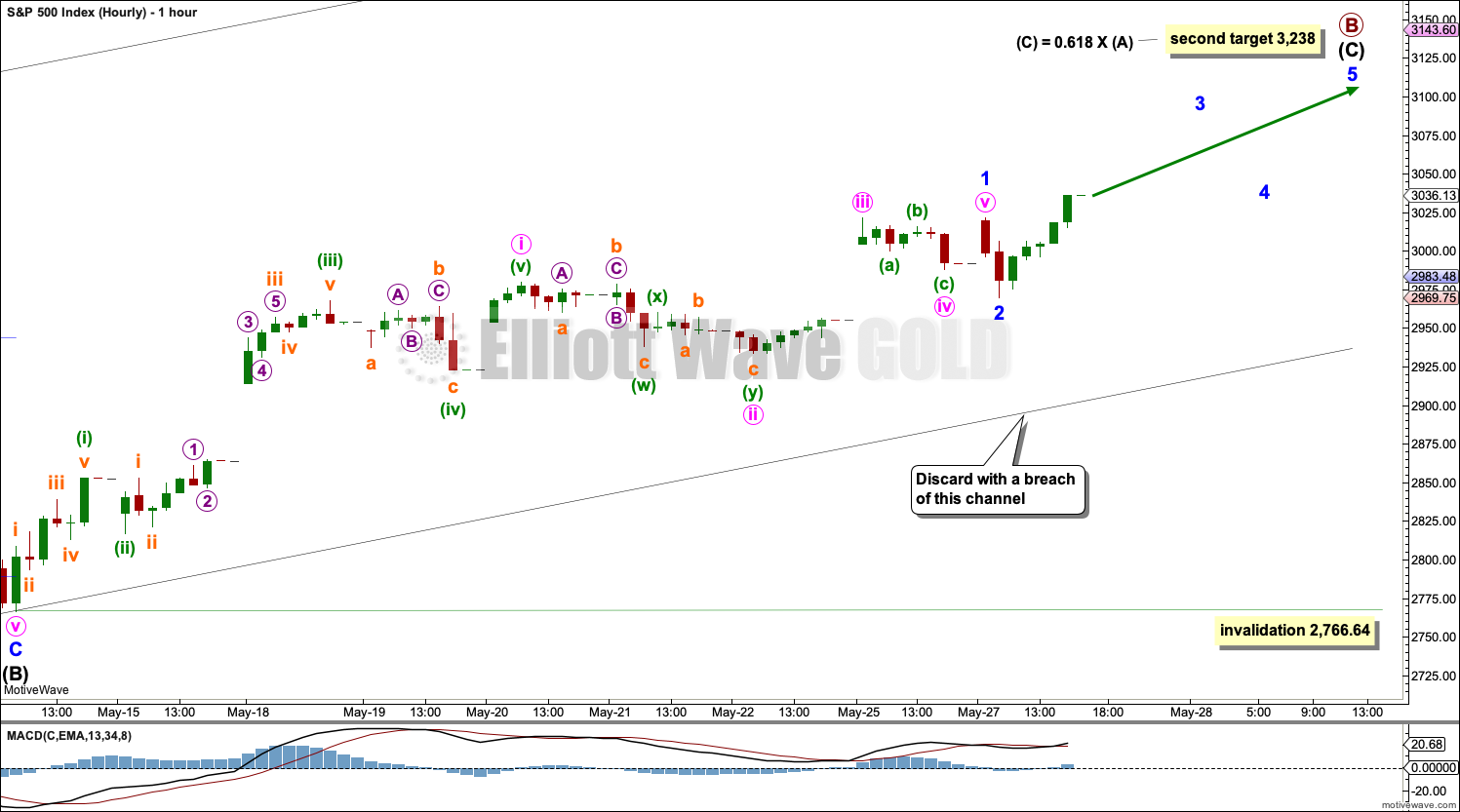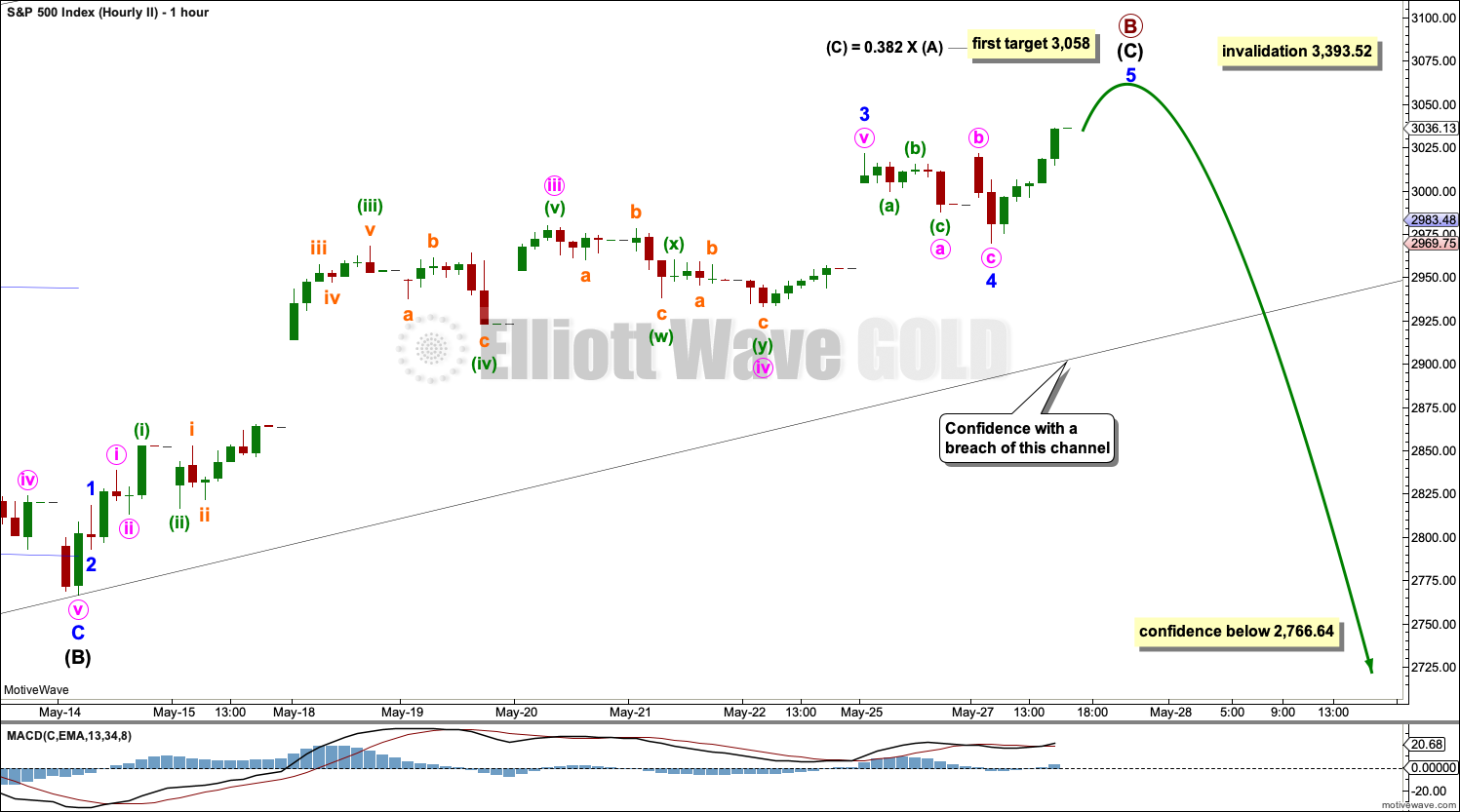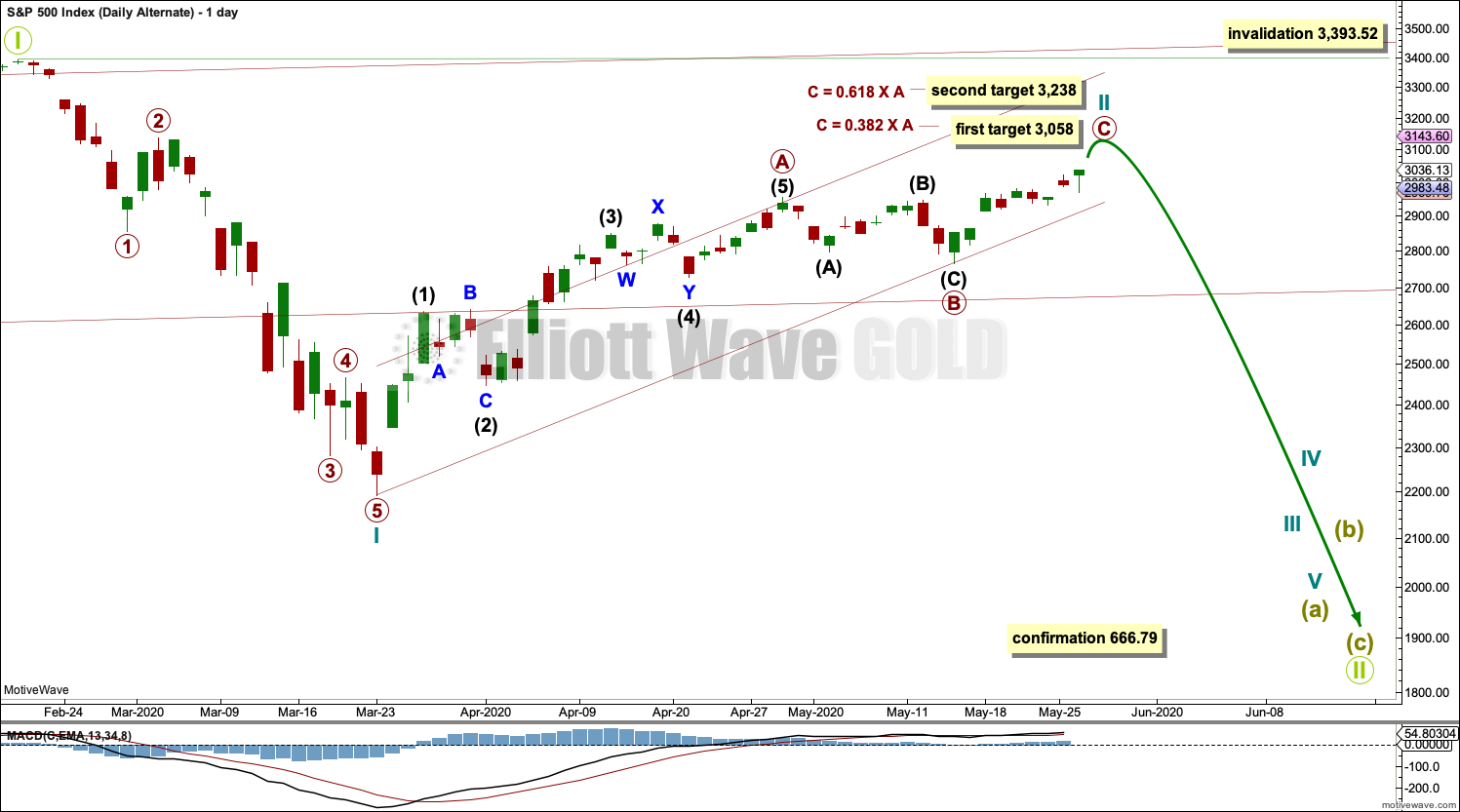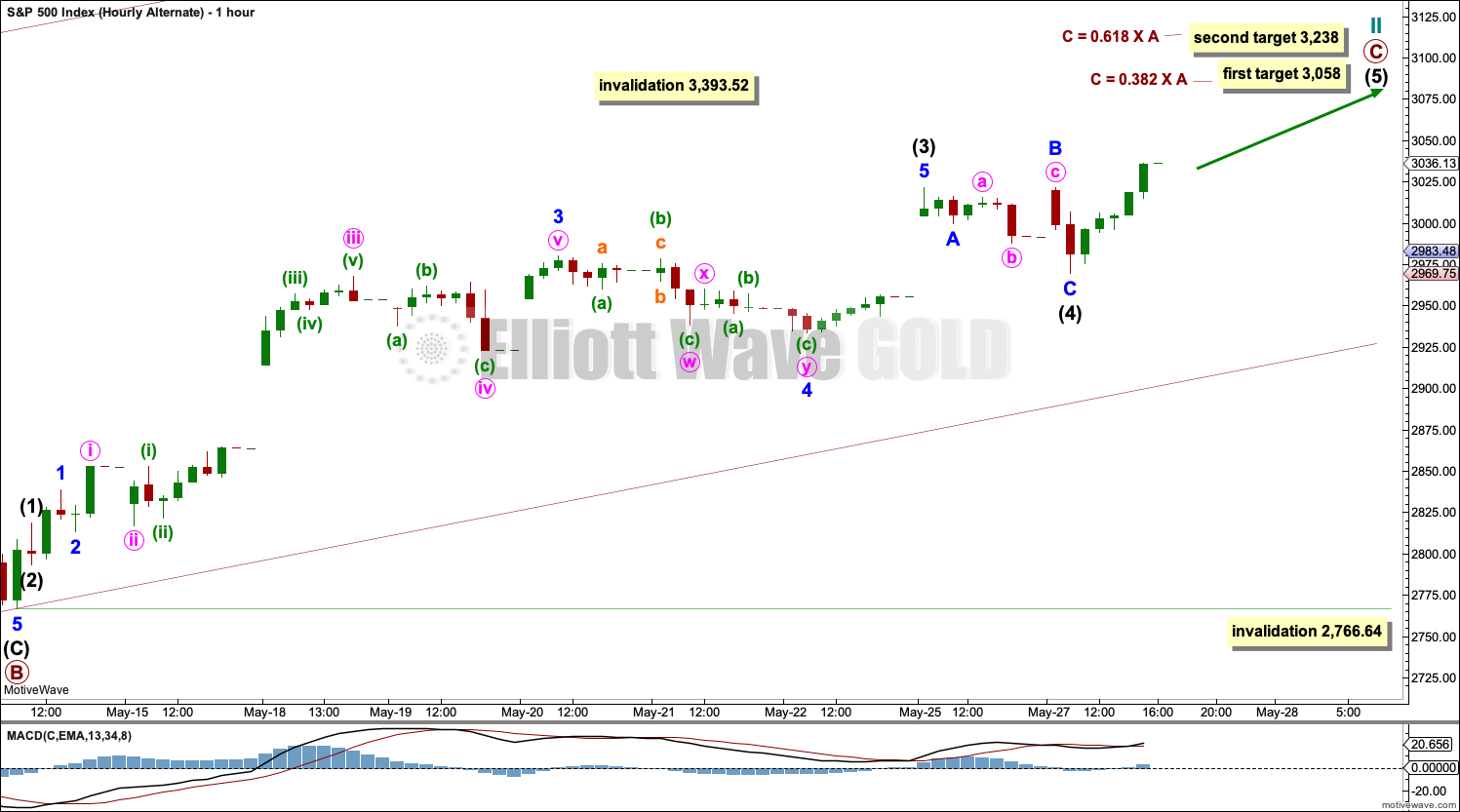S&P 500: Elliott Wave and Technical Analysis | Charts – May 27, 2020
Upwards movement was expected this week, which is what has happened. Price now approaches the first of two targets.
Summary: Targets remain at 3,058 or 3,238. Use the lower edge of the Elliott channel to indicate where support may be found on the way up.
The bounce may be over and the bear market may have resumed if the following are seen:
1. A bearish candlestick reversal pattern.
2. A breach of the black upwards sloping Elliott channel on the main daily chart by downwards movement.
3. A new low below 2,766.64.
This bounce that began on 23rd of March is still expected to be a counter trend bounce within an ongoing bear market. When the bounce is complete, then the bear market is expected to resume with strength.
The biggest picture, Grand Super Cycle analysis, is here.
Last monthly charts are here. Video is here. Members are encouraged to view all three monthly charts. The third is much more bearish than this main wave count and remains a valid possibility.
ELLIOTT WAVE COUNTS
WEEKLY CHART
This main Elliott wave count expects that the bull market beginning in March 2009 was cycle wave I of Super Cycle wave (V). The trend change in February 2020 may have been only at cycle degree. Cycle wave II may last from one to a few years.
Cycle wave II would most likely subdivide as a zigzag; thus far that looks like what is unfolding. When primary waves A and B may both be complete, then the target may be calculated using a Fibonacci ratio between primary waves A and C. At that stage, the final target may change or widen to a zone.
Cycle wave II may not move beyond the start of cycle wave I below 666.79.
DAILY CHART
Draw the wide maroon trend channel carefully: draw the first trend line from the end of primary wave 1 at 2,093.55 (December 26, 2014), to the end of primary wave 3 at 2,940.91 (September 21, 2018), then place a parallel copy on the end of primary wave 2 at 1,810.10 (February 11, 2016). The channel is fully breached indicating a trend change from the multi-year bull trend to a new bear trend. Resistance at the lower edge has been overcome; price has closed above this trend line.
Cycle wave II may subdivide as any Elliott wave corrective structure except a triangle. It would most likely be a zigzag (zigzags subdivide 5-3-5). Primary wave A may be a complete five wave impulse downwards. Primary wave B may not move beyond the start of primary wave A above 3,393.52.
Draw a channel about primary wave B using Elliott’s technique for a correction. Draw the first trend line from the start of intermediate wave A to the end of intermediate wave B, then place a parallel copy on the end of intermediate wave A. Intermediate wave C may find resistance at the upper edge of the channel. While intermediate wave C unfolds higher, any smaller pullbacks within it may find support at the lower edge of this channel.
When this channel is breached by downwards movement, it would then indicate the bounce labelled primary wave B may be over and the next large downwards wave labelled primary wave C may then have begun.
FIRST HOURLY CHART
Intermediate wave (C) may continue for another one to three weeks.
Intermediate wave (C) must subdivide as a five wave motive structure, either an impulse or an ending diagonal. An impulse is much more likely, so that is what shall be expected unless overlapping suggests a diagonal.
Minor wave 1 may have ended. Upwards movement subdivides as a completed five wave impulse. Minor wave 2 may also be complete as a relatively brief and shallow zigzag. If minor wave 2 continues lower as a double combination or expanded flat, then it may not move beyond the start of minor wave 1 below 2,766.64.
This first wave count now fits best with the second higher target.
SECOND HOURLY CHART
It is possible that intermediate wave (C) is very close to completion and may end tomorrow.
This labelling fits with MACD. The strongest momentum is within the third wave.
If price breaks below the lower edge of the trend channel, then this wave count would be the most likely scenario. At that stage, a target for primary wave C would be calculated that would be reasonably below the end of primary wave A at 2,191.86.
ALTERNATE DAILY CHART
This alternate daily chart follows the Second Alternate Monthly chart published here. Video is here.
By simply moving the degree of labelling in the bull market beginning March 2009 up one degree, it is possible that a Grand Super Cycle trend change occurred on February 19, 2020. The bull market from March 2009 to February 2020 may have been a complete fifth wave labelled Super Cycle wave (V).
A bear market at Grand Super Cycle degree may be expected to last at least a decade, possibly longer. Corrections for this market tend to be much quicker than bullish moves, and so a fair amount of flexibility is required in expectations for duration of the different degrees.
Grand Super Cycle II would most likely subdivide as a zigzag, although it may be any corrective structure except a triangle. It should begin with a five down at the weekly chart time frame, which would be incomplete.
The first wave down on the daily chart is labelled cycle wave I. If this degree of labelling is wrong, it may be too high; it may need to be moved down one degree.
Following cycle wave I, cycle wave II may be continuing higher as a zigzag. Cycle wave II may not move beyond the start of cycle wave I above 3,393.52.
When cycle wave II may again be complete, then a target for cycle wave III may be calculated.
ALTERNATE HOURLY CHART
Cycle wave II may be a continuing higher as a single zigzag. Hourly wave counts for the main daily chart work in the same way for this alternate. The degree of labelling for this alternate is all one degree higher.
TECHNICAL ANALYSIS
WEEKLY CHART
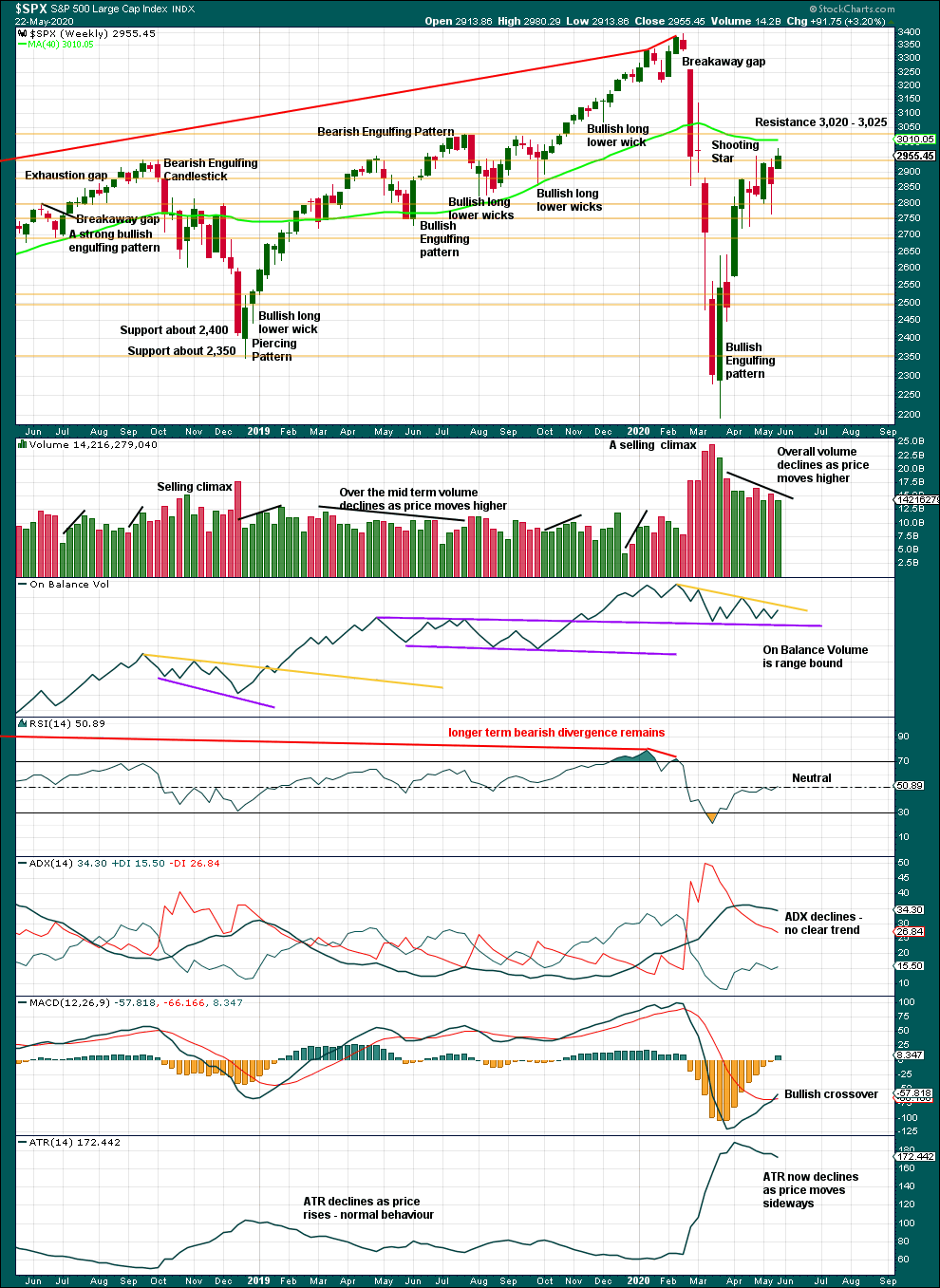
Click chart to enlarge. Chart courtesy of StockCharts.com.
Both price and On Balance Volume have resistance just above. Upwards movement may be limited. The bounce has both declining volume and range, exhibiting weakness. This supports the Elliott wave count.
DAILY CHART
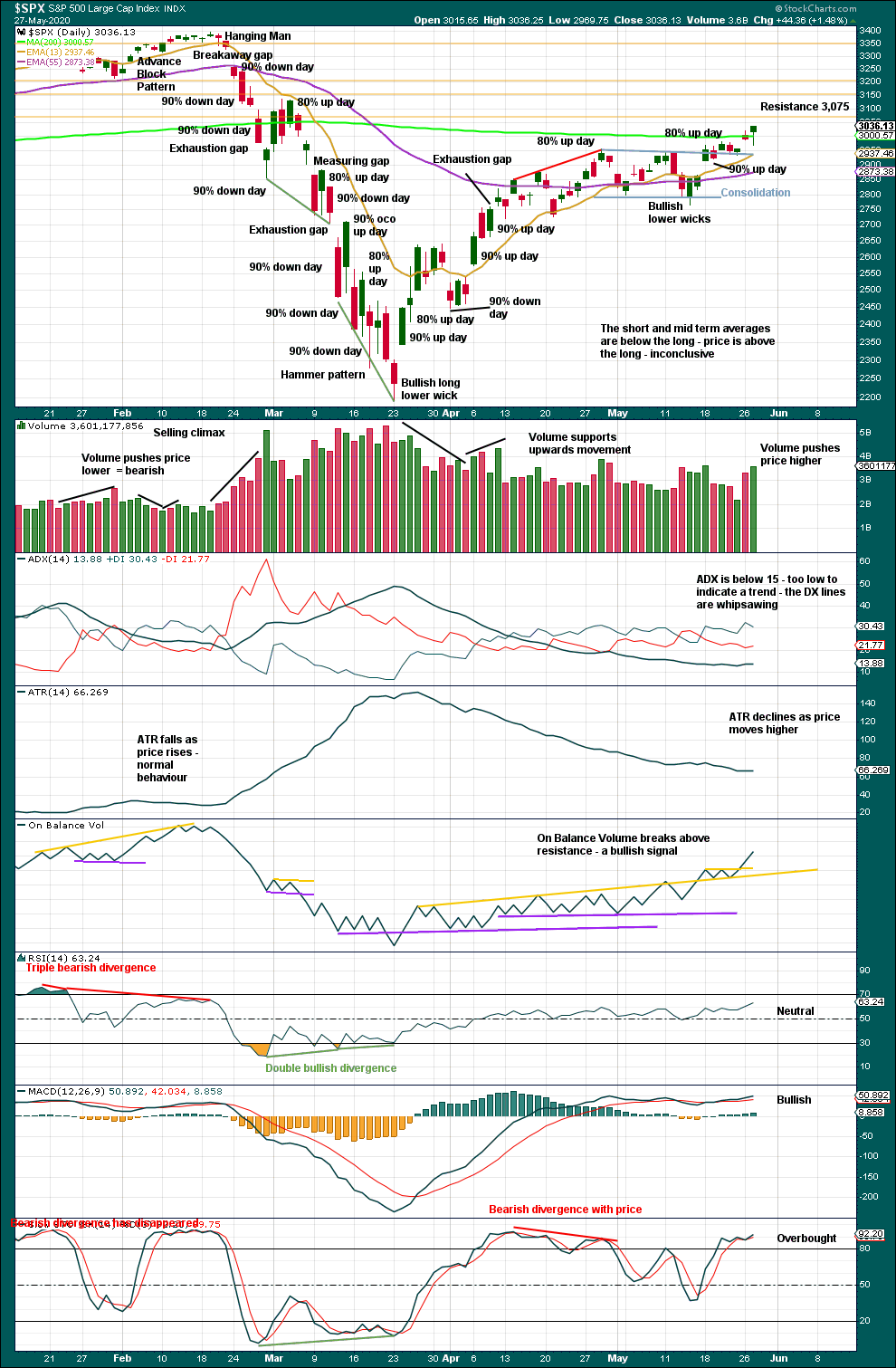
Click chart to enlarge. Chart courtesy of StockCharts.com.
In the bear market from October 2000 to March 2009, the first multi-day bounce retraced 0.73 of the first wave down. In the bear market from March 2000 to October 2002, the first multi-day bounce retraced 0.89 of the first wave down. So far this current bounce has retraced 0.69 of the first wave down, so it seems reasonable that it could continue higher. However, it is now very near a normal level for the first big retracement. Resistance just above from the 200 day moving average and 3,075 may halt a rise in price.
To see what signals may be looked for to identify a high, the two previous large bear markets were analysed in end of week analysis. The DotCom crash was analysed here with video here. The Global Financial Crisis was also analysed here with video here.
In recent days there has been one 90% up day and now an 80% up day. There is enough strength in upwards movement to expect it to continue at least for the short term.
Today a strong push from volume, a close almost at the high of the session, and a long lower wick all suggest more upwards movement tomorrow.
BREADTH – AD LINE
WEEKLY CHART
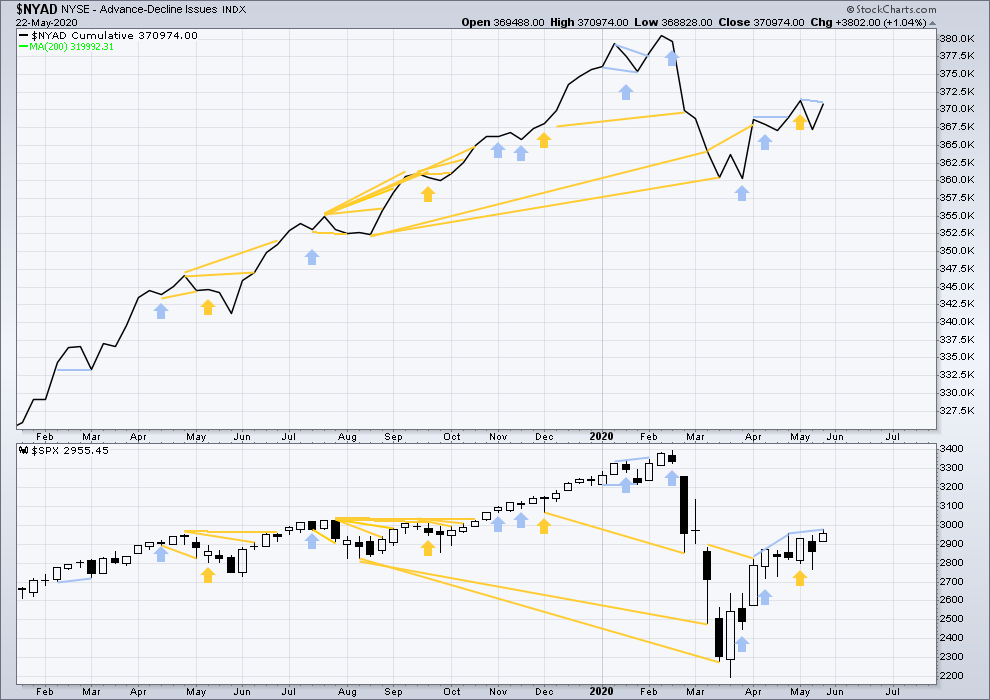
Click chart to enlarge. Chart courtesy of StockCharts.com. So that colour blind members are included, bearish signals will be noted with blue and bullish signals with yellow.
Breadth should be read as a leading indicator.
This week price has made a slight new high above the prior swing high of 2-3 weeks ago, but the AD line has not. Upwards movement lacks support from a corresponding rise in market breadth. This divergence is bearish.
Large caps all time high: 3,393.52 on 19th February 2020.
Mid caps all time high: 2,109.43 on 20th February 2020.
Small caps all time high: 1,100.58 on 27th August 2018.
DAILY CHART

Click chart to enlarge. Chart courtesy of StockCharts.com. So that colour blind members are included, bearish signals will be noted with blue and bullish signals with yellow.
Today the AD line has made a new high above the prior high of the 4th of March, but price has not. This divergence is bullish and supports the first hourly Elliott wave count.
VOLATILITY – INVERTED VIX CHART
WEEKLY CHART
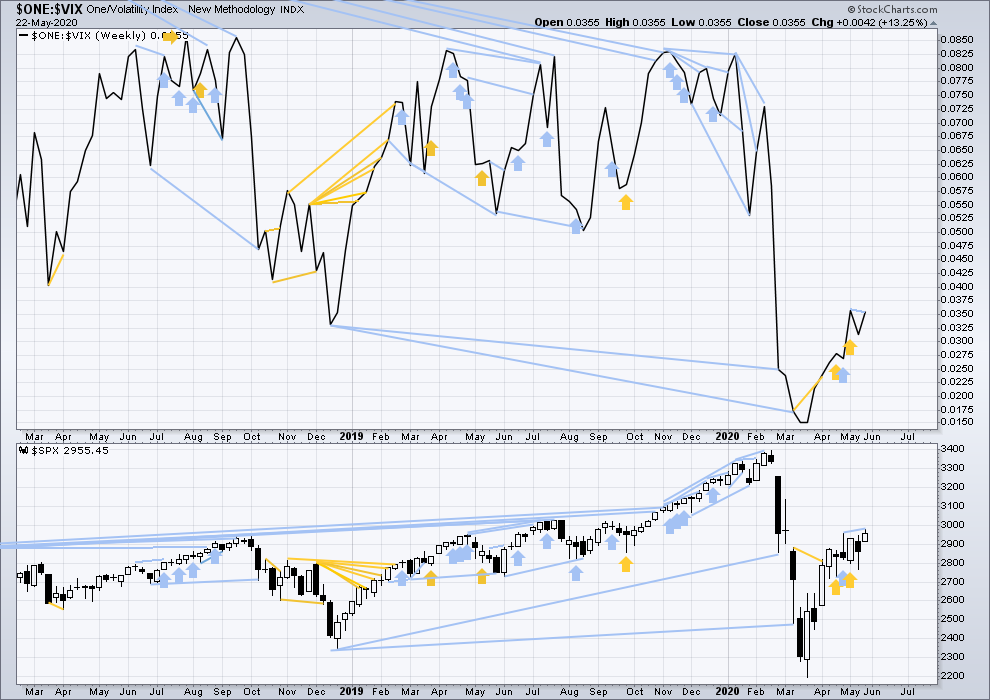
Click chart to enlarge. Chart courtesy of StockCharts.com. So that colour blind members are included, bearish signals will be noted with blue and bullish signals with yellow.
This week price has made a slight new high above the prior very short-term swing high 2-3 weeks ago, but inverted VIX has not. This divergence is bearish. It is short term and weak.
DAILY CHART
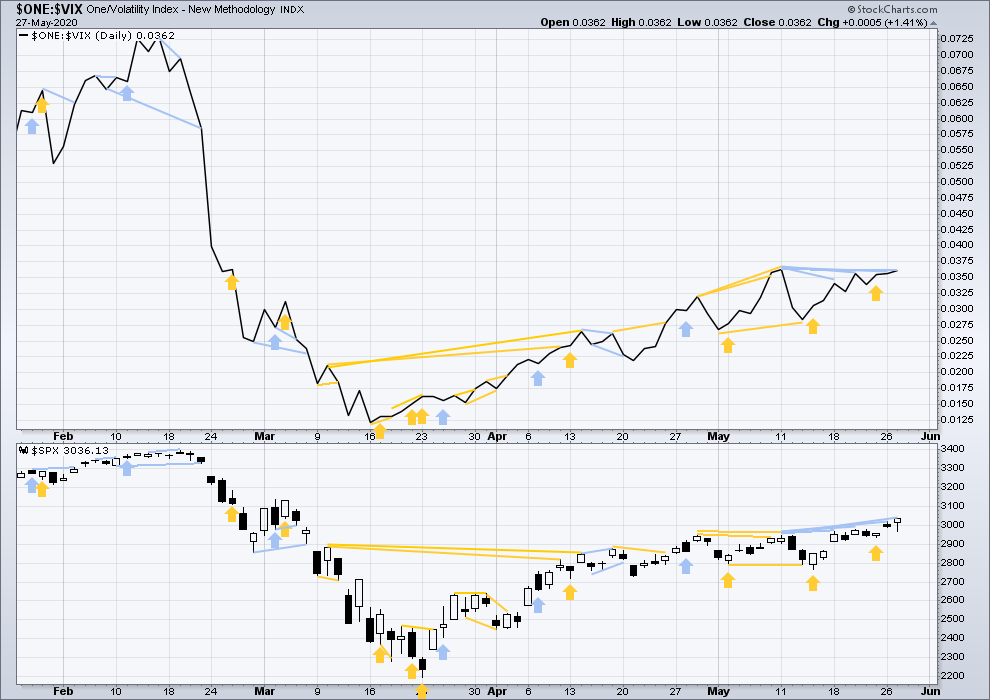
Click chart to enlarge. Chart courtesy of StockCharts.com. So that colour blind members are included, bearish signals will be noted with blue and bullish signals with yellow.
Bearish divergence noted in last analysis has not been followed by any downwards movement. Again, today both price and inverted VIX have moved higher, but only price has made a new high above the prior high of the 11th of May. This divergence again is bearish, but it is very slight.
DOW THEORY
Dow Theory has confirmed a bear market with the following lows made on a closing basis:
DJIA: 21,712.53 – a close below this point has been made on the March 12, 2020.
DJT: 8,636.79 – a close below this point has been made on March 9, 2020.
Adding in the S&P and Nasdaq for an extended Dow Theory, a bear market has now been confirmed:
S&P500: 2,346.58 – a close below this point has now been made on March 20, 2020.
Nasdaq: 7,292.22 – a close below this point was made on the March 12, 2020.
Published @ 06:58 p.m. EST.
—
Careful risk management protects your trading account(s).
Follow my two Golden Rules:
1. Always trade with stops.
2. Risk only 1-5% of equity on any one trade.
—
New updates to this analysis are in bold.

